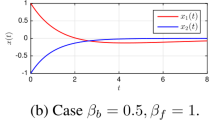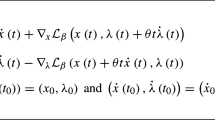Abstract
In a Hilbert space setting, this paper is devoted to the study of a class of first-order algorithms which aim to solve structured monotone equations involving the sum of potential and nonpotential operators. Precisely, we are looking for the zeros of an operator \(A= \nabla f +B \), where \(\nabla f\) is the gradient of a differentiable convex function f, and B is a nonpotential monotone and cocoercive operator. This study is based on the inertial autonomous dynamic previously studied by the authors, which involves dampings controlled respectively by the Hessian of f, and by a Newton-type correction term attached to B. These geometric dampings attenuate the oscillations which occur with the inertial methods with viscous damping. Temporal discretization of this dynamic provides fully splitted proximal-gradient algorithms. Their convergence properties are proven using Lyapunov analysis. These results open the door to the design of first-order accelerated algorithms in numerical optimization taking into account the specific properties of potential and nonpotential terms.




Similar content being viewed by others
References
Abbas, B., Attouch, H., Svaiter, B.F.: Newton-like dynamics and forward-backward methods for structured monotone inclusions in Hilbert spaces. J. Optim. Theory Appl. 161(2), 331–360 (2014)
Adly, S., Attouch, H.: Finite convergence of proximal-gradient inertial algorithms combining dry friction with Hessian-driven damping. SIAM J. Optim. 30(3), 2134–2162 (2020)
Adly, S., Attouch, H., Vo V.N.: Asymptotic behavior of Newton-like inertial dynamics involving the sum of potential and nonpotential terms (2021). https://hal.archives-ouvertes.fr/hal-03213925
Alecsa, C.D., László, S., Pinta, T.: An extension of the second order dynamical system that models Nesterov’s convex gradient method. Applied Mathematics and Optimization (2020). https://doi.org/10.1007/s00245-020-09692-1
Alvarez, F., Attouch, H.: An inertial proximal method for maximal monotone operators via discretization of a nonlinear oscillator with damping. Set-Valued Anal. 9(1–2), 3–11 (2001)
Alvarez, F., Attouch, H., Bolte, J., Redont, P.: A second-order gradient-like dissipative dynamical system with Hessian-driven damping. Application to optimization and mechanics. J. Math. Pures Appl. 81(8), 747–779 (2002)
Attouch, H., Cabot, A.: Convergence of a relaxed inertial proximal algorithm for maximally monotone operators. Math. Program. 184, 243–287 (2020)
Attouch, H., Chbani, Z., Fadili, J., Riahi, H.: First-order algorithms via inertial systems with Hessian-driven damping. Math. Program. (2020). https://doi.org/10.1007/s10107-020-01591-1, hal-02193846
Attouch, H., Chbani, Z., Peypouquet, J., Redont, P.: Fast convergence of inertial dynamics and algorithms with asymptotic vanishing viscosity. Math. Program. Ser. B 168, 123–175 (2018)
Attouch, H., László, S.C.: Continuous newton-like inertial dynamics for monotone inclusions. Set-Valued Var. Anal. (2020). https://doi.org/10.1007/s11228-020-00564-y
Attouch, H., László, S.C.: Newton-like inertial dynamics and proximal algorithms governed by maximally monotone operators. SIAM J. Optim. 30(4), 3252–3283 (2020)
Attouch, H., Maingé, P.E.: Asymptotic behavior of second order dissipative evolution equations combining potential with nonpotential effects. ESAIM Control Optim. Calc. Var. 17(3), 836–857 (2011)
Attouch, H., Maingé, P.E., Redont, P.: A second-order differential system with Hessian-driven damping; application to nonelastic shock laws. Differ. Equ. Appl. 4(1), 27–65 (2012)
Attouch, H., Marques Alves, M., Svaiter, B.F.: A dynamic approach to a proximal-Newton method for monotone inclusions in Hilbert Spaces, with complexity \(\cal{O}(1/n^2)\). J. Convex Anal. 23(1), 139–180 (2016)
Attouch, H., Peypouquet, J.: Convergence of inertial dynamics and proximal algorithms governed by maximal monotone operators. Math. Program. 174(1–2), 391–432 (2019)
Attouch, H., Peypouquet, J., Redont, P.: Fast convex minimization via inertial dynamics with Hessian driven damping. J. Differ. Equ. 261(10), 5734–5783 (2016)
Attouch, H., Redont, P., Svaiter, B.F.: Global convergence of a closed-loop regularized Newton method for solving monotone inclusions in Hilbert spaces. J. Optim. Theory Appl. 157(3), 624–650 (2013)
Attouch, H., Svaiter, B.F.: A continuous dynamical Newton-Like approach to solving monotone inclusions. SIAM J. Control Optim. 49(2), 574–598 (2011)
Baillon, J.-B., Haddad, G.: Quelques propriétés des opérateurs angles-bornés et n-cycliquement monotones. Isr. J. Math. 26, 137–150 (1977)
Bauschke, H., Combettes, P.L.: Convex Analysis and Monotone Operator Theory in Hilbert Spaces. CMS Books in Mathematics, Springer, Berlin (2011)
Boţ, R.I., Csetnek, E.R.: Second order forward-backward dynamical systems for monotone inclusion problems. SIAM J. Control Optim. 54, 1423–1443 (2016)
Boţ, R.I., Csetnek, E.R., László, S.C.: Tikhonov regularization of a second order dynamical system with Hessian damping. Math. Program. (2020). https://doi.org/10.1007/s10107-020-01528-8
Castera, C., Bolte, J., Févotte, C., Pauwels, E.: An Inertial Newton Algorithm for Deep Learning. (2019), HAL-02140748
Kim, D.: Accelerated proximal point method for maximally monotone operators. Math. Program. Ser. A, (accepted)(2020). Preprint available at arXiv:1905.05149v3
Lin, T., Jordan, M.I.: A control-theoretic perspective on optimal high-order optimization (2019). arXiv:1912.07168v1
Nesterov, Y.: A method for solving the convex programming problem with convergence rate \(O(1/k^2)\). (Russian) Dokl. Akad. Nauk SSSR 269(3), 543–547 (1983)
Maingé, P.E.: First-order continuous Newton-like systems for monotone inclusions. SIAM J. Control Optim. 51(2), 1615–1638 (2013)
Shi, B., Du, S.S., Jordan, M.I., Su, W.J.: Understanding the acceleration phenomenon via high-resolution differential equations. Math. Program. (2018). https://doi.org/10.1007/s10107-021-01681-8
Su, W., Boyd, S., Candès, E.J.: A differential equation for modeling Nesterov’s accelerated gradient method. J. Mach. Learn. Res. 17, 1–43 (2016)
Author information
Authors and Affiliations
Corresponding author
Additional information
Publisher's Note
Springer Nature remains neutral with regard to jurisdictional claims in published maps and institutional affiliations.
Hedy Attouch: Supported by COST Action: CA16228.
Rights and permissions
About this article
Cite this article
Adly, S., Attouch, H. & Vo, V.N. Newton-Type Inertial Algorithms for Solving Monotone Equations Governed by Sums of Potential and Nonpotential Operators. Appl Math Optim 85, 44 (2022). https://doi.org/10.1007/s00245-022-09846-3
Accepted:
Published:
DOI: https://doi.org/10.1007/s00245-022-09846-3




